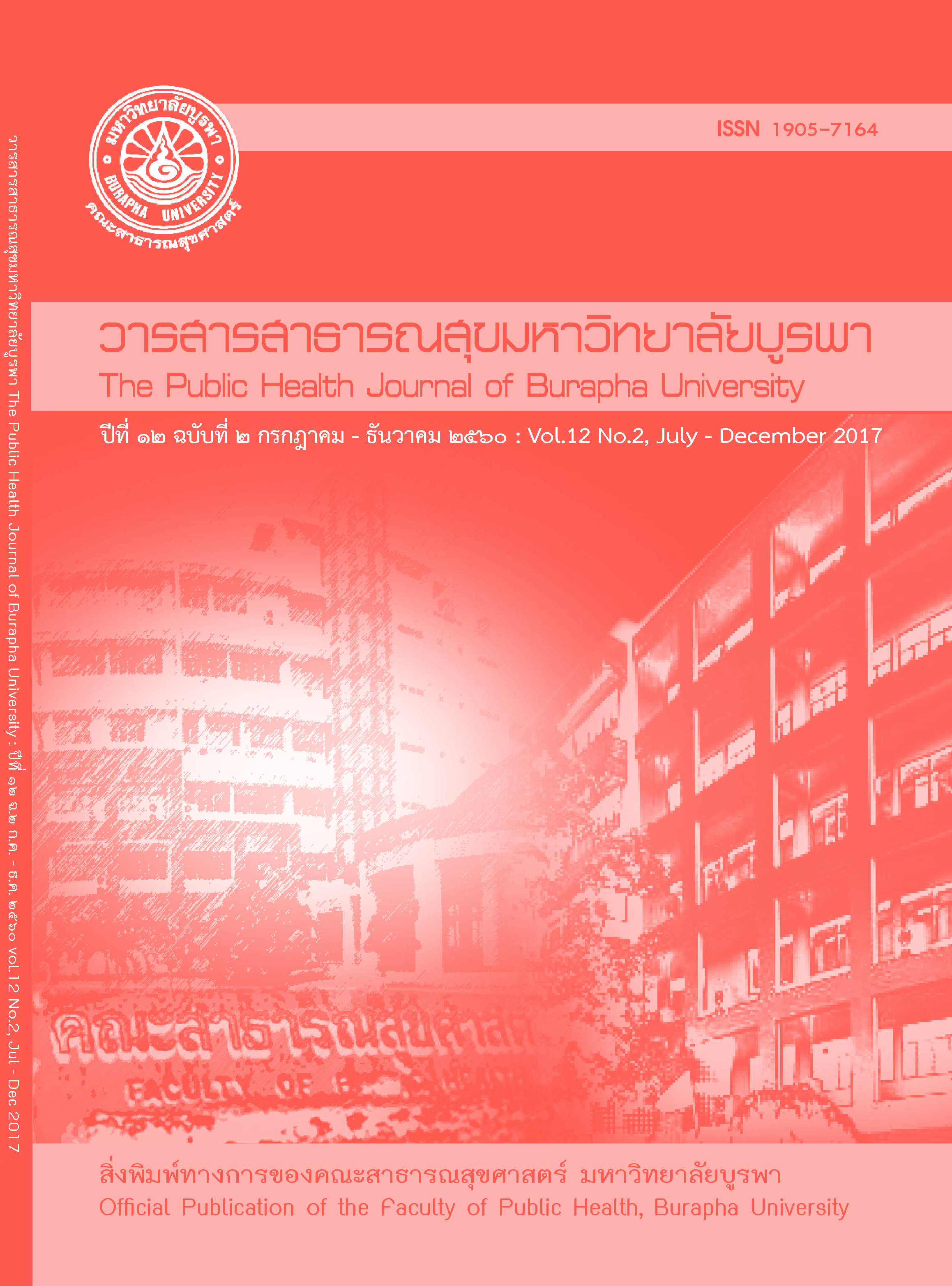อาการปวดตึงคอภาวะสุขภาพและผลกระทบจากอาการปวดของบุคลากรมหาวิทยาลัยบูรพา จังหวัดชลบุรี
Main Article Content
บทคัดย่อ
วัตถุประสงค์งานวิจัยเพื่อหาความชุกของอาการปวดตึงคอ ภาวะสุขภาพ ปัจจัยเสี่ยงและปัจจัยป้องกันสัมพัทธ์ ในบุคลากรของมหาวิทยาลัยบูรพา จังหวัดชลบุรี ทั้งสายวิชาการและสายสนับสนุน ระเบียบวิธีวิจัยเชิงพรรณนารูปตัดขวาง โดยกลุ่มตัวอย่างได้มาจากการสุ่มอย่างง่าย (simple random sampling) จากการตอบแบบสอบถามด้วยตนเอง (self administered questionnaire) ตามความสมัครใจจากแบบสอบถามที่สร้างขึ้นซึ่งประกอบด้วย 1. ข้อมูลทั่วไป 2. ภาวะสุขภาพ ทั่วไปตามแบบประเมิน Short form health survey (SF-36) ฉบับภาษาไทย 3. ข้อมูลผลกระทบจากอาการปวดต้นคอด้วย Neck Disability Index (NDI) และ 4.ข้อมูลพฤติกรรมสุขภาพ ระหว่างเดือน มกราคม –มีนาคม 2556และทำการวิเคราะห์โดยวิธีโลจิสติก รีเกรซชั่นชนิดหลายตัวแปร ผลจากผู้ตอบแบบสอบถามจำนวน 388 คน พบว่ามีความชุกของอาการปวดตึงคอเท่ากับ 80.1% (Prevalence = 80.1 %; 95% CI= 76.2 %- 84.1%) ส่วนใหญ่เป็นเพศหญิง(74%) คุณภาพชีวิต(SF-36) ในทุกมิติได้ผลค่าเฉลี่ยระหว่าง 56.7 - 70.9 คะแนนและอาการปวดตึงคอเล็กน้อยถึงปานกลางและส่งผลกระทบเล็กน้อยถึงปานกลางต่อสุขภาพ ( mean NDIs = 8.9- 20 points) โดยมีปัจจัยเสี่ยงอาการปวดตึงคอได้แก่ การมีโรคประจำตัว ( adj.OR = 2.41; 95%CI = 1.2-4.7) และผู้ที่มีชั่วโมงการทำงานในแต่ละวันสูง ( adj.OR = 1.02; 95%CI = 1.0-1.03) ส่วนปัจจัยป้องกันอาการปวดตึงคอได้แก่ การบริโภควิตามินเสริม ( adj.OR = 0.39; 95%CI = 0.19-0.62)การออกกำลังกาย ( adj.OR = 0.49; 95%CI = 0.3—0.8) และการตรวจสุขภาพประจำปี( adj.OR = 0.41; 95%CI = 0.2-0.7)สรุป แม้ผลความชุกของอาการปวดตึงคอสูงถึง 80% แต่ส่วนใหญ่ยังมีอาการส่งผลกระทบต่อสุขภาพเพียงเล็กน้อยถึงปานกลาง ซึ่งสามารถทำการรักษาและป้องกันเพื่อให้หายจากอาการและ ไม่ให้อาการรุนแรงหรือแปรเป็นเจ็บป่วยเรื้อรังได้
Article Details
References
2. Carey et al. Race, care seeking and utilization for chronic back and neck pain: population perspectives, J pain. 2010 April. ; 11(4):343-350. DOI 10.1016/j.jpain.2009.08.003
3. Fejer R, Kyvik KO, Hartvigsen J. The prevalence of neck pain in the world population: a systematic critical review of the literature, Eur Spine J 2006;15:834-848: DOI 10.1007/s00586-004-0864-4
4. Rezai M, Cote P, Cassidy JD,Carroll L, The association between prevalent neck pain and health related quality of life: a cross-sectional analysis. Eur Spine J 2009; 18:371-381
5. Salo et al., Effect of neck strength Training on Health-related quality of life in females with chronic neck pain: a randomized controlled 1-year follow up study Health and Quality of Life Outcomes 2010;8:48:DOI:10.1186/1477-7525-8-48.
6. Hogg-Johnson S, Van der Velde G, CarrollL J, et al., The Burden and Determinants of Neck Pain in General Population, Results of Bone and Joint Decade 2000-2010 task force on neck pain and its associated disorders, Eur Spine J 2008; 17 suppl 1 :S39-S51.
7. Portero P and Genries V. An update of neck muscle strength: From isometric to isokinetic assessment, Isokinetics and Exercise Science 2003; 11:1-8.
8. RSIA online directory, Tension neck syndrome (cited 2012 Oct. 20) Available from: http://rsi.org.uk/conditions/tension_neck_syndrome.html
9. Electronic database of Burapha university personal(cited 2012 Jun. 20) Available from: http://person.buu.ac.th/codes/Official/Rpt/Rpt3-1.php?TxtLIW_ID=&TxtHIRE_ID=&TxtCAP_ID=&TxtFAC_ID=&TxtDEP_ID
10. Leurmarnkul W and Meetam P. Properties Testing of the Retranslated SF-36 (Thai Version)/Thai J. Pharm. Sci. 2005; 29 (1-2): 69-88.
11. Thanita Luekumnueporn. , Cross-cultural adaptation and psychometric testing of the Thai version of the neck disability index in patients with mechanical neck pain, Chulalongkorn University, 2007.
12. Wiphasiri Saiphiroonthong, Charas Choaksuwankij, Aurapan Chaimanee., Association between sedentary work and obesity among medical personnel in Nopparat Rajathanee Hospital. The Public Health Journal of Burapha University. 2015; 10(2):34-43.
13. Erick PN, Smith DR. A systematic review of musculoskeletal disorders among school teachers. BMC Musculoskeletal Disorders. 2011 Nov 17; 12:260.
14. Walton DM, Carroll LJ, Kasch H, Sterling M, Verhagen AP, MacDermid JC, et al. An Overview of Systematic Reviews on Prognostic Factors in Neck Pain: Results from the International Collaboration on Neck Pain (ICON) Project. Open Orthop J. 2013 Sep 20; 7:494–505.
15. Hush JM, Michaleff Z, Maher CG, Refshauge K. Individual, physical and psychological risk factors for neck pain in Australian office workers: a 1-year longitudinal study. Eur Spine J. 2009. Oct ; 18(10):1532–40.
16. Chiu TW, Ku WY, Lee MH, Sum WK, Wan MP, et al. A Study on the Prevalence and Risk Factors for Neck Pain among University Academic Staff in Hong Kong. Journal of Occupational Rehabilitation. 2002 Jun;12.2: 77-91:DOI: http://dx.doi.org/10.1023/A:1015008513575
17. Yue P, Lui F, Li L, Neck/shoulder pain and low back pain among school teachers in China, prevalence and risk factors.BMC Public Health 2012;12:789: DOI:10.1186/1471-2485-12-789
18. Cheung J, Kajaks T, Joy C. MacDermid. The relationship between Neck pain and Physical Activity. The open Orthopedics J. 2013;7:521-529
19. Sjogaard G, Sogaard K, Muscle activity pattern dependent pain development and alleviation. Journal of electromyography and kinesiology. 2014 Dec ;24:789-794: DOI: http://dx.doi.org/10.1016/j.jelekin.2014.08.005.
